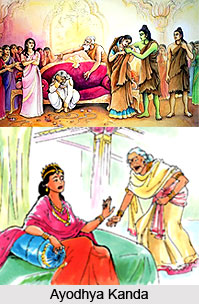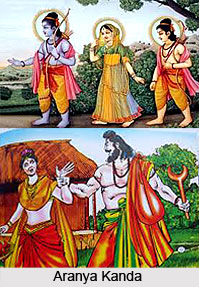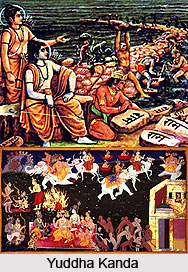 Episodes in Ramayana are segregated into seven Kandas which include the Bala Kanda, Ayodhya Kanda, Aranya Kanda, Kishkindha Kanda, Sundara Kanda, Yuddha Kanda and Uttara Kanda. The Bala Kanda gives an account of the birth of Rama as well as his childhood days and his marriage to Devi Sita, the daughter of Raja Janaki. The Ayodhya Kanda speaks of the preparations for the coronation of Rama along with his exile into the forest. The life in forest of Rama, his brother Lakshmana and Devi Sita and the kidnapping of Sita by Ravana is described in the Aranya Kanda. The Kishkinda Kanda provides detailed information regarding the meeting of Rama with Hanuman, the destruction of Vali, the Vanara king, and the coronation of Sugriba, Vali`s younger brother, as the king of Kishkindha. Sundara Kanda is the fifth episode, which gives a description of the heroic works of Hanuman, his Lanka endeavor and his meeting with Devi Sita. Yuddha Kanda, as the name suggests, narrates the yuddha or war between the armies of Ravana and Rama. The last episode is Uttara Kanda, which gives an account of the birth of the two sons of Rama and Sita, Lava and Kusha, their coronation and the final departure of Rama from the world.
Episodes in Ramayana are segregated into seven Kandas which include the Bala Kanda, Ayodhya Kanda, Aranya Kanda, Kishkindha Kanda, Sundara Kanda, Yuddha Kanda and Uttara Kanda. The Bala Kanda gives an account of the birth of Rama as well as his childhood days and his marriage to Devi Sita, the daughter of Raja Janaki. The Ayodhya Kanda speaks of the preparations for the coronation of Rama along with his exile into the forest. The life in forest of Rama, his brother Lakshmana and Devi Sita and the kidnapping of Sita by Ravana is described in the Aranya Kanda. The Kishkinda Kanda provides detailed information regarding the meeting of Rama with Hanuman, the destruction of Vali, the Vanara king, and the coronation of Sugriba, Vali`s younger brother, as the king of Kishkindha. Sundara Kanda is the fifth episode, which gives a description of the heroic works of Hanuman, his Lanka endeavor and his meeting with Devi Sita. Yuddha Kanda, as the name suggests, narrates the yuddha or war between the armies of Ravana and Rama. The last episode is Uttara Kanda, which gives an account of the birth of the two sons of Rama and Sita, Lava and Kusha, their coronation and the final departure of Rama from the world.
Bala Kanda in Ramayan
One day the hermit Valmiki inquired of the great rishi Narada whether he could tell of any man living perfect in goodliness, virtue, courage, and benevolence. Then Narada related to him all the story that is now called the Ramayana, for such a man as Valmiki desired to hear of was the great Rama. Bala Kanda also gives an account of the beautiful city called Ayodhya and its king was Dasharatha, a veritable Manu amongst men, a moon amongst the stars. Only one desire of Dasharatha`s was unsatisfied: he had no son to carry on his line. Because of this, after many vain austerities, he determined at last on the greatest of all offerings-a horse sacrifice; and calling the family priests and other Brahmins, he gave all necessary orders for this undertaking. When a year had passed the horse that had been set free returned, and Rishyasringa and Vashishtha performed the ceremony, and there was great festivity and gladness. Then Rishyasringa told the king that four sons would be born to him, perpetuators of his race; at which sweet words the king rejoiced exceedingly. The marriage of Rama with Sita, the daughter of Janaka is also described in the Bala Khanda.
Ayodhya Kanda in Ramayan
This episode or Kanda in Ramayana gives and elaborate description of the declaration of the King of Ayodhya, Dasaratha, that his elder son Rama will be the heir to the throne of his kingdom. This news was spread all over the place and people of Ayodhya rejoiced to get a very good king. However, Kaikeyi, one of the wives of Dasaratha, planned to make her son Bharata the king of Ayodhya in place of Rama. Manthara, one of the dasi (maid servant) of Kaikeyi reminded her of an ancient pledge; how long ago in a great battle with the Rakshasas Dasharatha had been wounded and almost slain; how Kaikeyi had found him unconscious on the battle field, and borne him to a place of safety and there healed him and how Dasharatha had granted her two boons, and she reserved those boons to ask them from him when and as she would now ask her husband for these boons that Bharata should be sworn in as the King of Ayodhya and Rama will be banished to the forest for fourteen years.
 This Kanda speaks of the dilemma of Dasaratha as to keep his work given to Kaikeyi long ago or to make his son Rama the King of Ayodhya and his ultimate death after the departure of Rama along with Lakshmana and Sita to the forest.
This Kanda speaks of the dilemma of Dasaratha as to keep his work given to Kaikeyi long ago or to make his son Rama the King of Ayodhya and his ultimate death after the departure of Rama along with Lakshmana and Sita to the forest.
Aranya Kanda in Ramayan
The Aranya Kanda narrates the forest life of Lord Rama and Devi Sita along with Lakshmana, who also went to the forest out of love and dedication towards his elder brother Rama. Surpanakha, being wounded b y Lakshmana went in front of her brother Ravana informed him of Rama and his wife Sita and compelled him to take revenge from them. Ravana then took away Rama and Lakshmana away from the hut by following devious means and went to the hut in the disguise of a wandering yogi stole Sita from the forest. This episode also describes the search for Sita by the two brothers in the forest.
Kishkindha Kanda in Ramayan
This episode narrates the friendship of Rama with Sugriba and his killing of Bali, the king of Kishkinda and the coronation of Sugriba to the throne. Rama also meets the great monkey, Hanuman. Against the restoration of Kishkinda to Sugriba, Rama gets help of the Banara sena of Sugriba to fight against Ravana.
Sundara Kanda in Ramayan
Sundara Kanda narrates the incident of Ashoka Vatika in Lanka where Sita was imprisoned by the demon king Ravana and the meeting of Hanuman with her. Hanuman meets Sita in Lanka and eats plenty of delicious fruits in Ashoka Vatika and lastly burns the whole of Lanka except the home of Vivishan, one of the gentle brothers of Ravana who afterwards befriends Rama and helps him to kill Ravana and rescue Sita. Then Hanuman returns to give his message to Rama regarding the condition of Sita and about the kingdom of the demon king.
Yuddha Kanda in Ramayan
This Kanda starts with severe difference of opinion between Ravana and his brother Vivishan and he leaves Lanka to meet Rama. Rama, along with Hanuman and Vivishan discussed among themselves as to how they could cross the ocean to reach Lanka along with their Banara sena (army). With the advice of the ocean and the help of Nala, the son of Viswakarma, the bridge was constructed by the Banara sena. With the completion of the bridge which cleared an easy access to Lanka, the Banara sena marched over it and surrounded the kingdom of the demon king from all sides. There is also a description of the wounds given to Rama and Lakshmana along with the Banaras by Indrajit, the son of Ravana.
 In Yuddha Kanda, the awakening of Kumbhakarna by the order of Ravana is mentioned. Kumbhakarna was one of the brothers of Ravana who stays awake for six months and sleeps completely for six months. Rama killing Kumbhakarna and the defeat of Indrajit and the final war between Rama and Ravana and the ultimate death of Ravana in the hands of Rama form a part of the Yuddha Kanda. Lastly, the union of Rama and Sita takes place which was rejoiced by all but then the episode of the Agnipariksha of Devi Sita takes place.
In Yuddha Kanda, the awakening of Kumbhakarna by the order of Ravana is mentioned. Kumbhakarna was one of the brothers of Ravana who stays awake for six months and sleeps completely for six months. Rama killing Kumbhakarna and the defeat of Indrajit and the final war between Rama and Ravana and the ultimate death of Ravana in the hands of Rama form a part of the Yuddha Kanda. Lastly, the union of Rama and Sita takes place which was rejoiced by all but then the episode of the Agnipariksha of Devi Sita takes place.
Uttara Kanda in Ramayan
Uttara Kanda happens to be the last episode of Ramayana which deals with the return of Rama from the forest to his kingdom of Ayodhya after fourteen years and his coronation as the king of Ayodhya. However, Rama was hesitant to accept Sita for she stayed in the house of a different person for so many years and in reply Sita went inside the burning fire and was left unhurt, which was a symbol of her purity. This Khanda gives an account of the two sons of Rama, Lava and Kusha who were born to Sita in the ashram of Valmiki and also the last days of Lord Rama in the world.
All the seven episodes or Khandas are unique on their own and offer a very delightful and pleasant experience of the great epic Ramayana. Ramayana is one of the great epics of India which is attributed to the renowned Hindu sage, Valmiki. The sequence of this great epic is that it creates a curiosity in the mind of the reader to go ahead further. Thus, the Ramayana episodes elaborately describe various incidents of the epic so minutely that one gets an impression of being in the epic ages.












